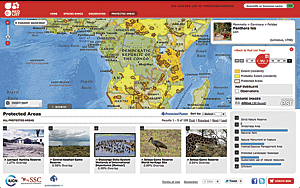Threatened-Species Authority—Esri User Conference Keynote Speaker
Julia Marton-Lefèvre Announces Release of Red List Portal

Julia Marton-Lefèvre
Julia Marton-Lefèvre, director general of the International Union for Conservation of Nature (IUCN), the world's largest conservation/environment membership organization, was the keynote speaker at the Esri International User Conference Plenary Session in San Diego, California, on July 23, 2012.
Marton-Lefèvre is distinguished in the global conservation community for her commitment to sustainable management of natural resources. "Our mission is to influence society to conserve nature and natural resources in an equitable and sustainable manner," she said. "Using cutting-edge geographic knowledge, IUCN mobilizes conservation action for the benefit of nature and the seven billion people who depend on it."
The IUCN Red List of Threatened Species is the most comprehensive information source on the status of wild species and sets the world standard to measure the extinction risk of plant and animal species. During her presentation, Marton-Lefèvre announced the release of the map portal for the IUCN Red List of Threatened Species.
Marton-Lefèvre explained the value of GIS for identifying location information for the several thousand species on the Red List, including all known mammals, birds, and amphibians and a quarter of the world's known reptiles. "GIS helps us define areas of heightened biodiversity importance and thereby guides decisions about the conservation action and policies for these areas," she said.
The IUCN Red List of Threatened Species
IUCN's enormous knowledge center provides researchers with a base for studying species trends and helps policy makers understand where conservation action needs to occur and be enforced. IUCN's data and data from other species organizations is accessible via the IUCN website. The site includes an interactive map service, which is a GIS portal that allows visitors to easily visualize species' ranges and examine an abundance of scientific data.
For example, if people are interested in the species status of Panthera leo (lion), they can learn about it by searching the IUCN Red List of Threatened Species. GIS shows the locations where lions have most recently been reported, the limits of the lions' distribution range, and photos of lions taken at these locations. Moreover, users can engage with GIS. For instance, they can overlay the provided basemap with protected-area data and the range of the lion to see where the species is safe and where it is not. GIS shows threats to species, such as habitat loss caused by human encroachment and indiscriminate trophy hunting by poachers.

The geography of lion habitats can be studied and analyzed on the IUCN Red List of Threatened Species map service portal. See also the IUCN story map "A Gallery of Amazing Species".
In addition, the portal links to thousands of geotagged wildlife images. It draws source data from ARKive, Encyclopedia of Life, Global Biodiversity Information Facility, iNaturalist, and World Database on Protected Areas from the United Nations Environment Programme World Conservation Monitoring Centre.
The Find Species Near Me tool allows users to see a map of species in their area, including a species list, along with their Red List status.
The Species Map Editor tool helps scientists who have GIS skills easily enter species distribution data on an attribute form and digitize location areas using drawing tools to draw ranges.
IUCN georeferenced data is searchable on ArcGIS Online and is linked to the IUCN site for data download.
How It Was Built
Built on Esri ArcGIS 10.1 for Server, the IUCN Red List of Threatened Species portal seamlessly brings together six databases in a JavaScript-based application designed by Esri Partner Blue Raster (Arlington, Virginia). The application was deployed with the latest ArcGIS API for JavaScript version, which allowed the best user experience and performance for a global audience. The complex species range data was optimized for web delivery that provides access to the entire catalog of species ranges without sacrificing data display quality. The IUCN Red List of Threatened Species also leverages web services in open standards from several sources to provide seamless web maps with species observations (photos), range data, and protected-area intersections. The entire system is hosted by Amazon Elastic Compute Cloud, which enables IUCN to rapidly publish its applications. With a global audience relying on the IUCN Red List of Threatened Species for this critical data, the mapping tool is proving to be a very powerful device for conservation.
"The addition of GIS has changed the face of IUCN Red List of Threatened Species," concluded Marton-Lefèvre. "The technology has made it possible for threatened species information to be included in the decision-making process."
For more information, visit www.iucn.org or www.iucnredlist.org.